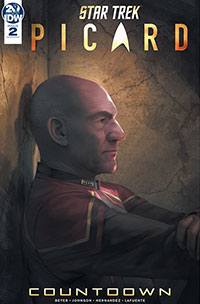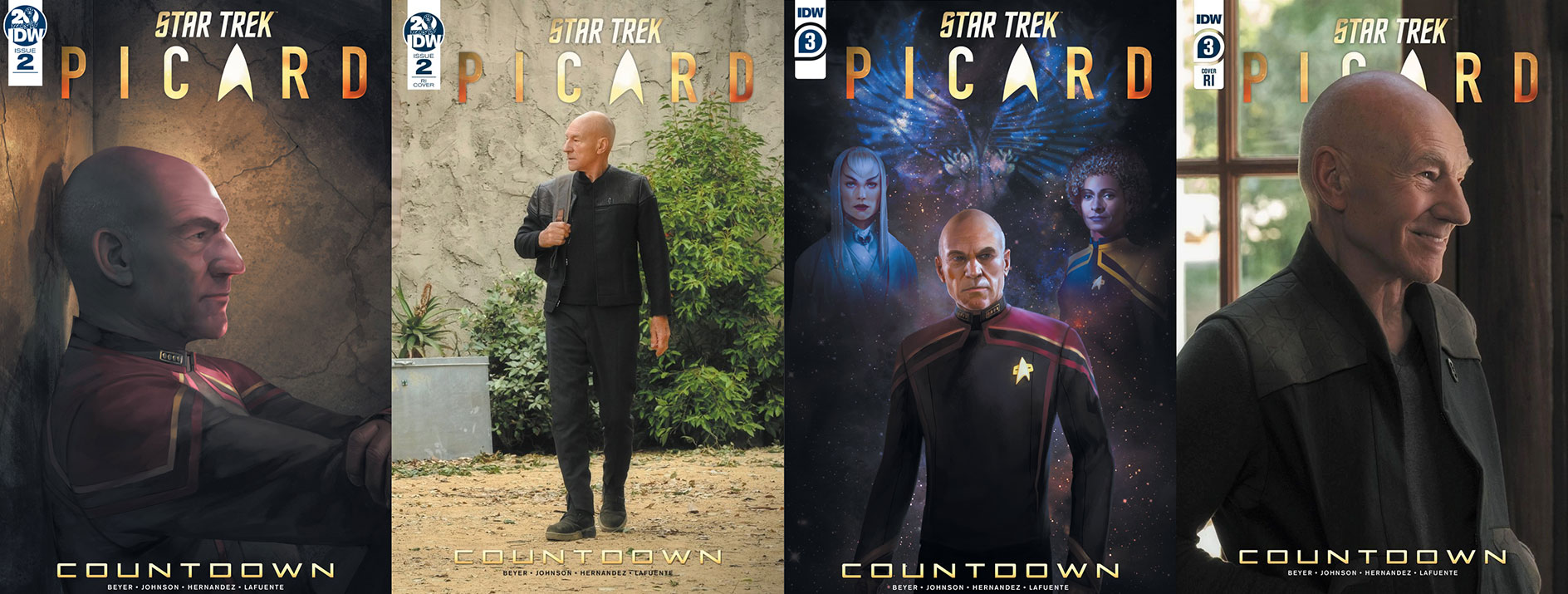Star Trek: Picard – Countdown, from writers Mike Johnson and Kirsten Beyer, with art by Angel Hernandez, successfully raised excitement for the Star Trek: Picard story — and came to a conclusion in late January after a three-issue run.
The story, since our review of the inaugural issue, barreled swiftly to its conclusion in its last two issues, giving us an origin story for two newly minted fan favorite Picard characters and filling in more of the backstory around Admiral Picard’s ultimately ill-fated attempt to lead an evacuation of large parts of the Romulan Empire.
The first chapter ended with Picard and his first officer, Raffi Musiker held in detention by the Romulan governess of Yuyat Beta, who refused to allow Picard to evacuate the native population in addition to the Romulan colonists.
Issue 2 picks up with Picard’s dilemma, still imprisoned and out of touch with his orbiting starship, the USS Verity. Picard is ultimately liberated by an attack on the Governor Shiana’s residence by a group of insurgents from the native population, who are being helped by two undercover members of the Tal Shiar: Laris and Zhaban.
Laris and Zhaban explain that they are helping Picard because during their years on the planet they have developed an affection for the native population, and also because they have fallen in love with each other — which is strictly against Tal Shiar protocol. In addition, they expose to Picard that the unfolding events at the colony are part of a Tal Shiar plot to sabotage Picard’s rescue efforts.
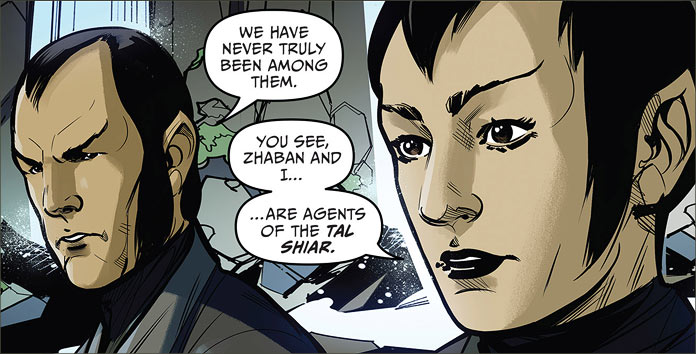
Meanwhile, Governor Shiana is implementing a plan of her own: to capture the USS Verity. Issue 2 ends with the Verity under Romulan control, swiftly ended by Picard’s arrival back aboard ship in the opening moments of Issue 3.
Picard confronts Shiana in the brig, where she describes her view of the Federation rescue effort; one designed to conquer the Romulan Empire through subterfuge. Before Picard’s reinforcements arrive, a Tal Shiar vessel decloaks. Zhaban, who traveled with Picard to the Verity, seems to double-cross Picard and commendeers the vessel himself.
His mission was apparently to earn Picard’s trust to ensure the destruction of the Verity as part of a coordinated Tal Shiar assault on Federation rescue efforts.
Admiral Picard gains the upper hand, however, when Romulan warbirds — who are allied with Picard’s rescue efforts — arrive on the scene, allowing Zhaban to reveal that he wasn’t double-crossing Picard… but double-crossing the Tal Shiar, revealing the full extent of their plans while returning control of the Verity to the admiral. With Governor Shiana in custody and the Tal Shiar’s plot foiled, the evacuation of the colony continues.
Now revealed as traitors to the Tal Shiar, Picard offers Laris and Zhaban sanctuary at a place that matches their skills with winemaking (as seen in the first issue): Chateau Picard. The issue ends with a final conversation with Geordi La Forge at the Utopia Planita shipyards, in which Admiral Picard signals a hopeful note for the future of the Romulan evacuation.
A hopeful future, which we now know from seeing the series’ first two episodes, does not come to pass.
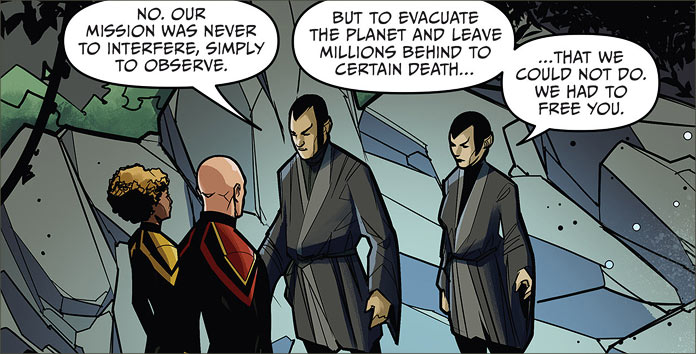
Countdown is a largely satisfying, but ultimately too brief, exploration of the Romulan evacuation and Picard’s role in its early days. There’s a lot to like about the story as a whole; it provides introductions for Musiker, Laris, and Zhaban. The pair of Romulan ex-pats have already cemented themselves as popular among Picard watchers, and so it is fun to see how they first met Picard and why they ended up working at his winery.
In addition, Countdown is the first place we actually see Picard working on the Romulan evacuation, whereas the series — through “The End is the Beginning,” at least — have focused on Utopia Planitia attack, and the aftermath of the Mars disaster which ended Starfleet’s evacuation plans.
But in Countdown we see that, despite the destruction of the rescue armada around Mars, the early phases of the evacuation were a success. Picard and Musiker were evacuating outlying colonies using the resources they had. And Countdown goes to show why Laris and Zhaban have a certain reverence for Picard, that goes deeper than their own personal situation.
“Sometimes I worry you have forgotten who you are. We have not,” Laris tells Picard in the Star Trek: Picard premiere; Countdown demonstrates why Picard is held in reverence by this pair of former Romulan agents.
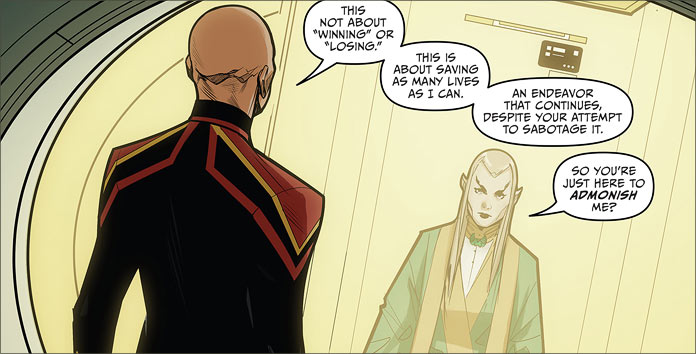
The story’s biggest drawback, however, its short length — and how brief everything feels as a result. While it provides a few more details about the state of the galaxy — and Picard’s early successes — I think it would have benefited from at least one more issue to allow the story more of an opportunity to breathe.
Due to the speed of the plot, there is little opportunity to explore the implications of… well, any of it. Picard retakes command of the Verity just as soon as he loses it, and the final confrontation wraps up at warp speed. The suspense worked better when there was a month’s gap between the release of each issue, but when read together many of the story’s twists are executed much too quickly.
The abbreviated story length is likely attributable to the push to make sure the comic was released in advance of the premiere of Star Trek: Picard — though a delay to Issue 3 allowed the series to premiere before the comic could wrap up its tale — and it certainly helped build the excitement and lay some of the groundwork. But for posterity’s sake, this story would have benefited from an additional issue, despite the additional time that would have taken to prepare.
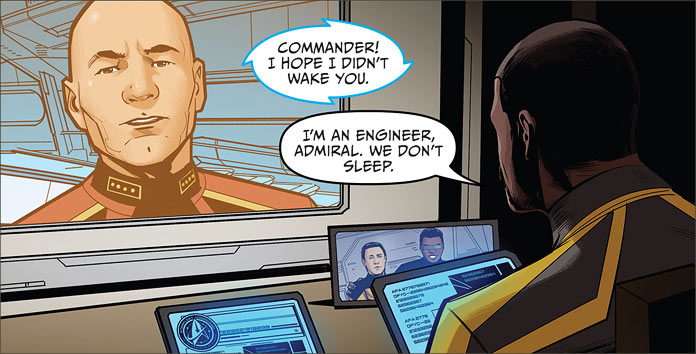
There are also both high points and low points about the art of Countdown. Artist Angel Hernandez does an excellent job with Picard and Musiker; you can really see Sir Patrick Stewart and Michelle Hurd shine through the page and inhabit their characters. In addition, the settings are eye catching and well designed, easily drawing your eye across the page from panel to panel.
However, Laris and Zhaban look almost nothing like their on-screen counterparts (played by Orla Brady and Jamie McShane). Indeed, if the characters had not introduced themselves, I doubt many would have deduced their connection to the show. That’s most unfortunate because, despite much as this story being a Picard story, the characters who are served best by the narrative are Laris and Zhaban.
Overall, Countdown does exactly what it was designed to do. It hyped the premiere of Picard, provided some important background that has not yet made it onto the screen, and started to acclimatize us to the 24th century we found as Picard awoke in the opening moments of “Remembrance.”
But maybe we should rename this series, given there’s been a pair of other Countdown tales from IDW’s creative team in years past. How about Star Trek: Laris and Zhaban?

